Smashing Conference Freiburg 2025
Posted in thoughts
Tags :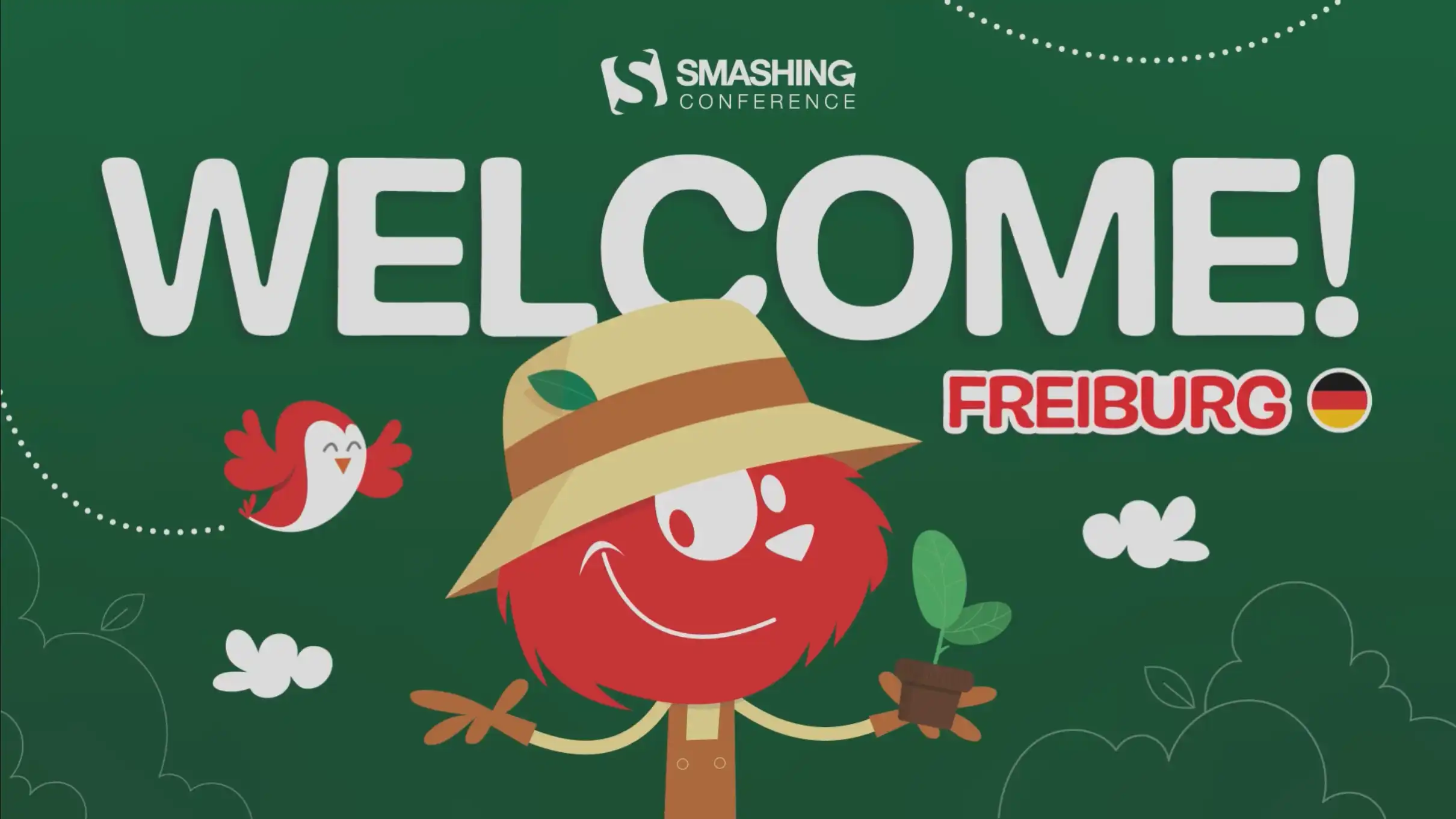
Smashing Conference is one of my all-time favourite web conferences, along with beyond tellerrand, New Adventures and @media.
They share a similar format and set of values: they are warm, welcoming and inclusive events, sporting a single track, ethical and human values (inclusive), they value sharing and open mind, encouraging curiosity, breaking silos and favouring human exchange and contact.
I’ve leaned so much from attending these events over the years, met fascinating and beautiful people, and got inspired. I usually leave with my brain in overdrive, walking above ground with a big smile – before reality hits me.
One might say these events preach to the choir, but it’s comforting to have your gut feelings, your instincts confirmed by the speakers’ talks or fellow participants. It’s good to feel you’re not alone. We’re all trying to do our best, for our users and stakeholders and beyond, but it’s not always easy and events such as Smashing Conference are so important and act as a reality check, a booster, an arm around your shoulder.
Falling back online
I had to cancel my trip last minute having befallen to some early seasonal bug that grounded me with flu/covid symptoms. Luckily for me, the talks are livestreamed via Vito. We were between 60 and 80 following online at any given time. I met a few new acquaintances before and between the talks, but the chat didn’t really act as a back channel. I miss the days when Twitter was the go to back channel for events like these. I tried to post a bit to Mastodon and Bluesky, but it isn’t quite the same.
Anyway, I followed the talks on my iPad, screen shooting slides and taking notes on my MacBook Pro. The image and sound quality were good, and side-by-side pictures worked well (slides + speaker). You can’t quite read the room, but you hear the laughs and clapping.
In the Flow
The quality of the talks was very high. Most of them got me in the right in the flow, I lost track of time, and before I knew it, it was all over. Similar to what I experience in person.
At the time of writing, I still have to watch the last two talks by Kevin Hawkins and Cassie Evans as I got interrupted yesterday afternoon (the downside of online viewing if you’re not careful - other people live with me at home).
Brad Frost
Brad, as he always does, gave a lively and colourful talk on the history of design systems and where we stand today. It resonated deeply with me as it matched my own experience and current situation with my clients.
I discovered Open UI, a W3C Community Group, which allows web developers to style and extend built-in web UI components and controls, with the goal to make it unnecessary to reinvent built-in UI controls and so many frameworks and design systems do today.
The last part of his talk introduced AI - the elephant in the room, proposing a constructive way of looking forward, and articulating so elegantly what I’ve been trying to share with my colleagues and clients this past year. AI is but a tool, not an end. We need our humanity today, more than ever – and boy do I feel it. We need to be able to think nuanced thoughts, we need critical thinking, evade and go beyond the false yes/no binaries.
Your humanity is what is needed in this moment in time. It’s not about which model to learn. […] We need to reclaim our curiosity and creativity.
We are Phil Collins *
(*) I won’t spoil you this part. You need to experience it live.
Emily Anderson
Emily talked about matters very close to my heart, in a similar way Amy Hupe did at Converge 2024. Our applications and products can harm people. Through seemingly inoffensive notifications and messages, Emily illustrated how blindly crafting for “delight” comes with emotional risks. In the same way, we have all sorts of budgets and unit tests during our development, we need to have something similar for our human experience to make sure we are truly inclusive. At each step, ask yourself “What can go wrong?”
Emily introduced the notion of Lenses, to consider different perspectives, to help you zoom out of this micro view we are all stuck in. We all have blind spots, it’s normal, but we need to be aware of them, and try to mitigate them.
Contrast and compare the user impact to the business impact help you share this approach with your stakeholders.
Don’t just rely on data. So much of we do today is, or is requred to be, “data driven”. For the best, or worse. (Kevin talks about the differences between “data informed” and “data driven”).
We need to remember that people cancel things because they have to […] Don’t blindly trigger modals or emails, but tailor our off-boarding experiences for/with understanding, clarity, trust, and a human experience.”
It’s about design for people, always.
Ana Rodrigues
Ana gave us a deep dive into one of my worst nightmares (well, not quite). Refactoring CSS, usually somebody else’s CSS. Walking us through maintenance strategies and ways to write tidy and non-chaotic CSS (I love that term). A real eye-opener, with lots of practical take aways and tools to help you audit your code.
If a bug fix isn’t tied to a specific requirement or feature, it gets labeled as “tech debt” and shoved to the bottom of the backlog. And let’s be honest: “tech debt” is corporate-speak for “we’ll deal with this never.”
You should have your own personal website.
Don’t procrastinate. Messes only grow with time. You can easily make excuses and hold off on doing something until the conditions are right, or things seems stable.
Perfection isn’t possible, but progress is.
— Abby Covert
Kardo Ayoub
Kardo shared the most personal and touching talk of them all. Kardo became visually impaired after brain surgery, losing the left side of his field of view. He walked us through his terrifying experience with humour and empathy, sharing invaluable first-hand insights.
I would have liked to be in the room for that talk, to feel the vibes. Listening to first-hand to the challenges he faces every moment of the day, gives you pause, and humbles you. We, as workers in a digital industry, don’t do enough to push the boundaries of what (inclusive) design can do. He notes that screen readers haven’t evolved much, if at all, this last decade. Why?
Humanity and empathy were at the heart of Kardo’s story. Today he combines all of his experience to design better experiences for all, in a truly inclusive way. I was touched and impressed by his energy, drive and commitment.
The hardest part is asking for help.
Matthias Ott
Matthias walked us through the history of the web, citing tent pole moment and making me feel even older as I’d lived through all of those. He talk was also full of practical tips and example, many of which you’ll find in his Pen or implemented on his newly relaunched website.
He touched and emphasised a point I’ve been trying to make these last years, nagging my clients all the way.
Let developers design
and let designers code
For me, it’s all about leaning more about how your colleagues’ work, what are their tools and how they use them. Breaking down those silos. I have leaned so much as a freelancer over the years, about writing, copy editing, typography, graphic design, photography, coding, sysadmins, you name it. I firmly believe that a better understanding of how your fellow colleagues deal with what they do, goes a long way in helping everyone row in the same direction.
I love Matthias’ work, open mind and will to share his experiments and findings. True to the nature of the web.
…and he did mention “design in the browser” ;)
That concluded the first day, and what a day it was!
Gemma O’Brien
On Flow
Gemma was this year’s mystery speaker. She took control of the format and the morning’s vibe off the bat by performing live calligraphy from a table set up on stage. I love calligraphy, and typography, and it was a sheer pleasure to watch Gemma shape her letters and join them together in a delicate mix of control and letting go.
Gemma is passionate. Full stop. No shortcuts, she goes deep down, into the details. I love it. She outlined her career as a designer and artist, best known for her bold graphics, illustrative lettering and stunning murals. Her work just blew me away. I would love to see some of her creations for real.
I really got hooked when Gemma started to talk about her latest endeveavour: neuroaesthetics. Yes, it was the first time I’d heard the word.
Neuroaesthetics is the scientific study of the neural bases for the contemplation and creation of a work of art.
She is conducting research on flow states in visual artists at Goldsmiths, University of London, as part of the MSc program in Neuroaesthetics.
Investigating the “perception, production, and response to art, as well as interactions with objects and scenes that evoke an intense feeling, often of pleasure.”
It struck a chord of my biologist background. Fascinating. What can science bring to the table to explain art or aesthetic preferences?
Gemma is studying Flow state. That moment when you are fully immersed in something, with a sense of personal control over the situation, losing track of time, and going down deeper into whatever the activity is, intrinsically rewarding.
Flow can be defined simply as “Optimal Experience” or “as the mental state of being completely present and fully immersed in a task, outside distractions recede from consciousness and one’s mind is fully open and attuned to the act of creating. There is very little self-awareness or critical self-judgment; just intrinsic joy for the task.” –Barry Kaufman
Scott Jehl
Scott walked us through the latest tools and processes to improve web performance for the broadest audience possible. I love these kinds of talks because I’ll always take away a number of tips and tricks I can add to my toolbox, and put immediately to good use.
Having worked with Harry Roberts this spring, and Scott’s talk complemented nicely what Harry presented us.
I did pick up Scott’s Vibe testing… - love the term.
Want links?
- www.charlesproxy.com
- web.dev/articles/vitals
- calibreapp.com
- www.webpagetest.org
- www.debugbear.com
- developer.chrome.com/docs/crux
- www.speedcurve.com
- blog.chriszacharias.com/page-weight-matters
- developer.chrome.com/docs/web-platform/early-hints
- purgecss.com
- developer.chrome.com/docs/web-platform/implementing-speculation-rules
Oliver Reichenstein
Oliver tooks us on a philosophy (for designers) ride, introducing us to many philosophers and theories, but centered around Kant’s Critique of Pure Reason. A fascinating talk, a little on the academic side, but with a lot of humour, and so pertinent to today.
Without attention, there is no love
Knowing how to make things, is essential, as we only understand what we make. So true, and so to date with all what AI is spitting out left and right.
Software is eating the world, now Al eats software
– (Raphael Schaad, the developer of iA Writer 1.0)
Reality is shared. In the moment, and truth itself is made, shared, and perpetually remade through interaction.
There are no multiple truths per se, but shared truths. A lot of food for thought here, as usual.
Manuel Matuzović
Manuel blew me away (again). I first heard him talk about colours at beyond tellerrand // berlin 2024, and was impressed by the amount of care and level of details he puts into his talks. Here again, I was tempted to try out the way he writes CSS, and experiment with his no-class approach. CSS @layers are so tempting, but I find it hard to retrofit them in existing projects. Manuel came up with a proposal of a very clear order and structure of the layer:
which are then broken down into sub layers.
He presented small snippets such as,
h1, h2, h3, h4, h5, h6 {
text-wrap: balance;
}
I loved the way he approached the typographic scale, and made it more abstract by iteration. Beautiful. Check out his slides.
: root {
--scale: 1.26;
--base: 1rem;
}
*, ::after, ::before {
--_type-power: pow(var(--scale), var(--exponent, o));
--_type-scale-formula: calc(var(--base) * var(--_type-power));
font-size: var(--font-size, var(--_type-scale-formula));
}
.big { --exponent: 10; }
.small { --exponent: -1; }
.custom { --font-size: 2rem; }
He presented a no-class CSS framework in the second part of his talk (oli.css) which was just up my street, and looks super engaging. I can’t wait to play around with the ideas he shared with us.
which ensures that headers are nicely balanced. Little touches.
- Fokus - uaplus.css
- Handbuch wien.gv.at
- Oli CSS - a modern no-class framework
So much positive energy, I was boosted in my seat. Don’t miss the video when it becomes public.
Cassie Evans
Cassie’s talk was refreshing and bouncy. Cassie built a game in canvas demonstrating the different usages of GSAP. Again, I loved the vibe, Cassie’s dexterity and humour.
Kill those Trello cards that inflict psychic damage.
Check it out on GitHub. The human touch again.
GSAP: use it anywhere - but HTML, CSS and JS
I loved the format and the vibe of Cassie’s talk. It was so entertaining and fun, and it motivated me to check out GSAP.
So nice to hear the promotion of human touches here and there.
Grateful
I consider myself priviledged to be able to attend events like these, meet people, catch-up with with friends and share stories and ideas. As a freelancer, I have tried to carve out time for conferences and workshops, and it has served me well. I consider it as important as reading and trying out things on the side.
There were several allusions to owning a personal website, and taking time to try out things, over the course of these two days, and I couldn’t agree more more. I would add teaching and sharing to the mix, as they close the circle of exploring, learning, building and sharing. As fulfilling building something can be, teaching is rewarding.
Thank you @smashingconf 💜
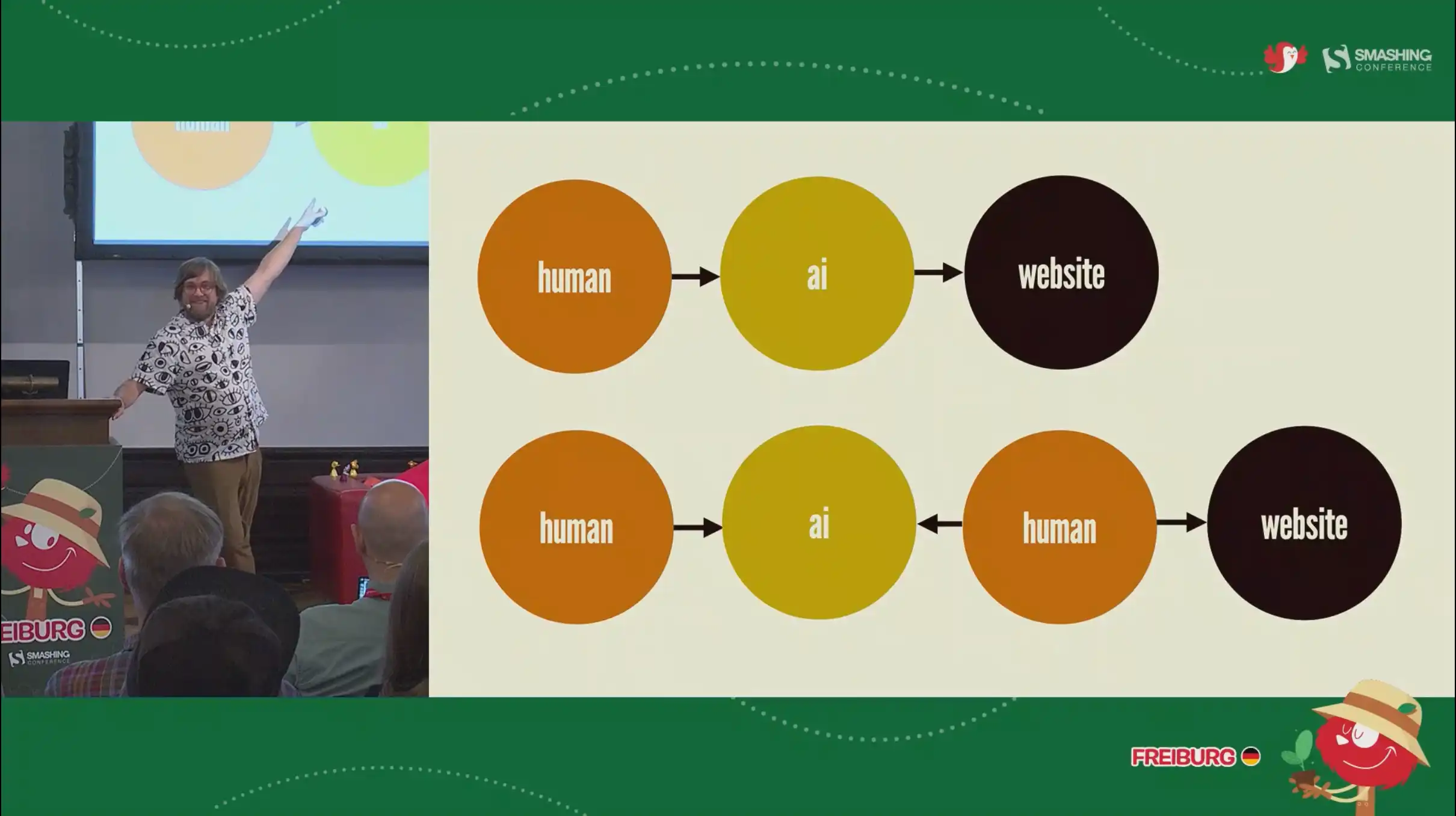
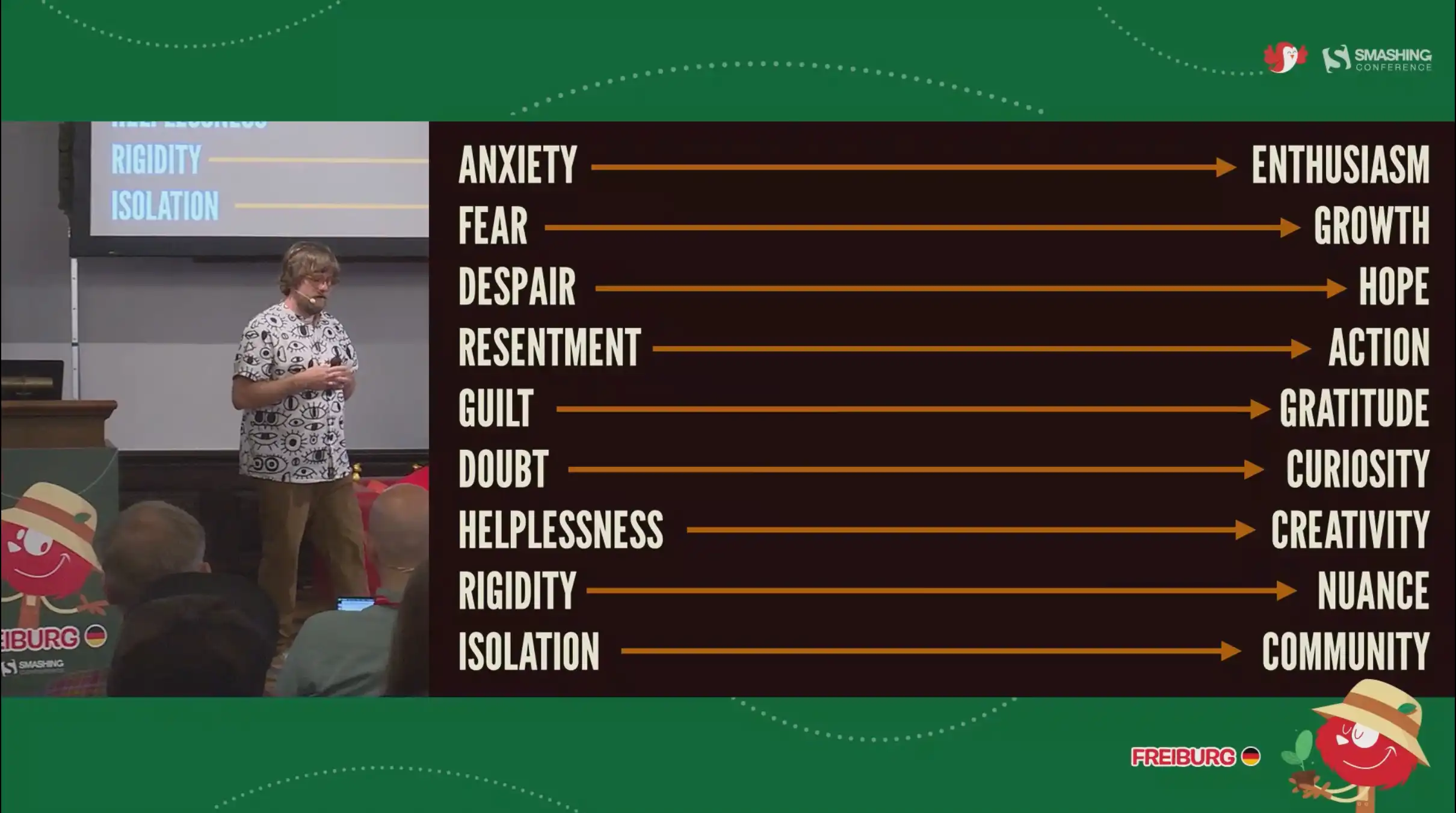
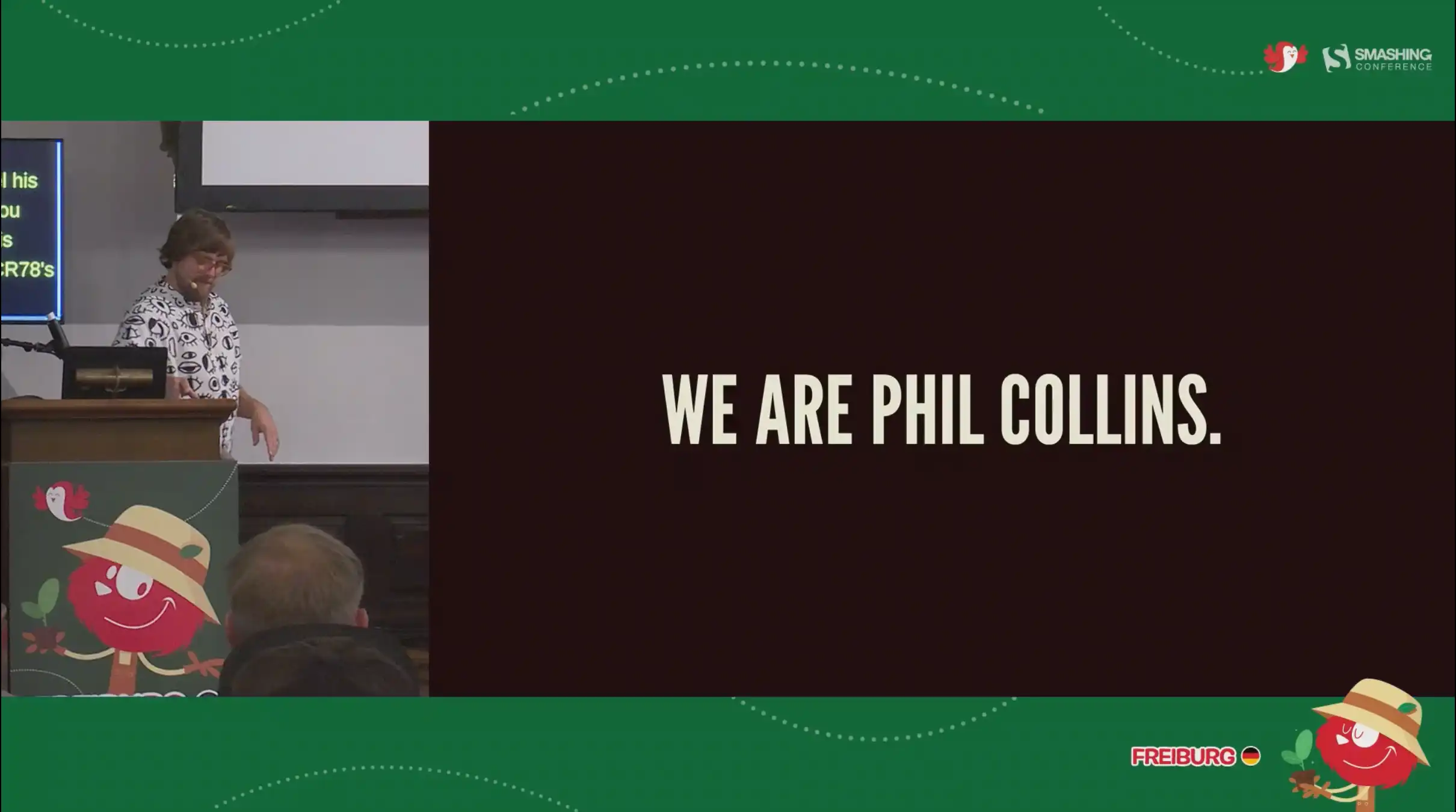
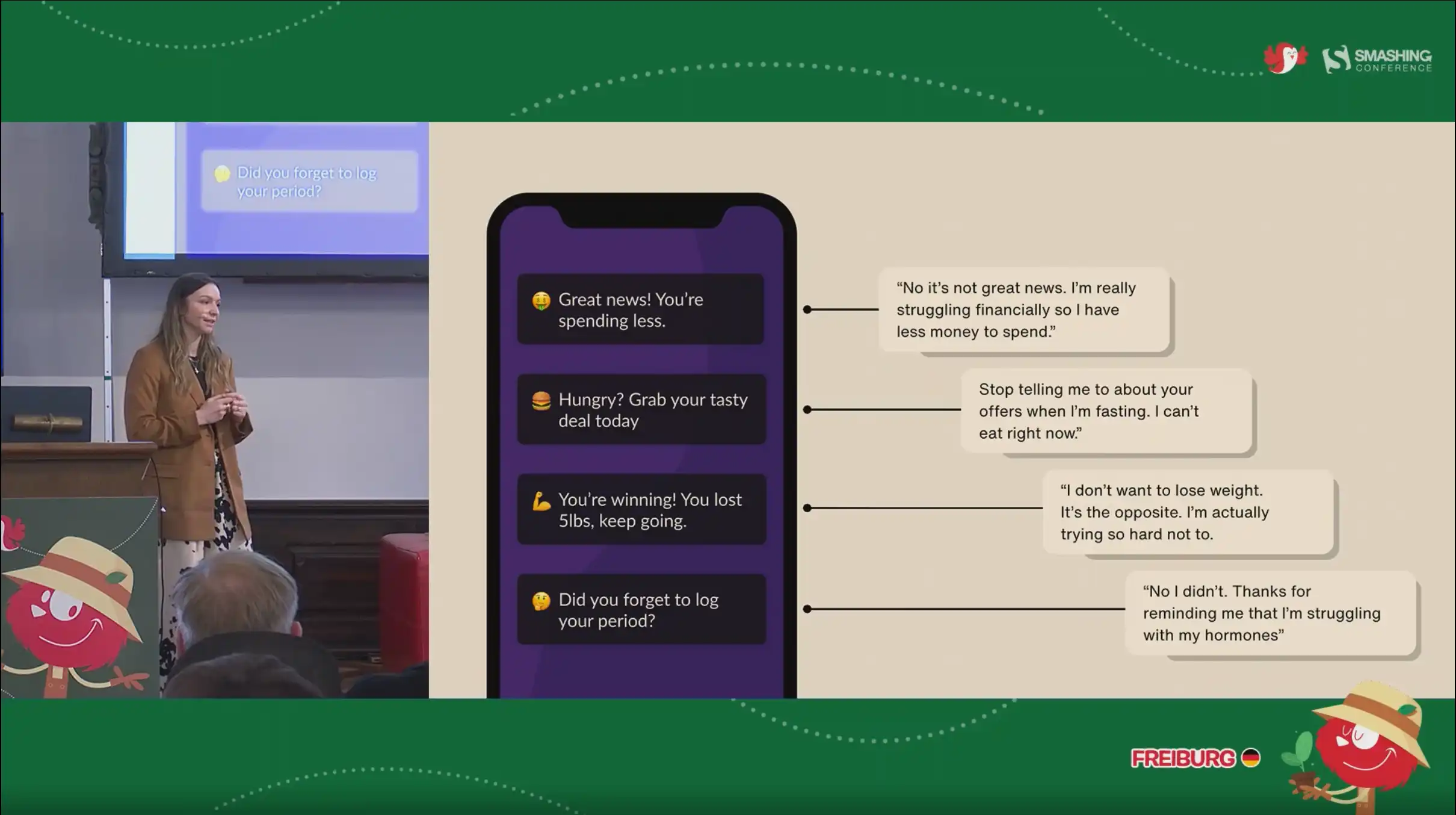
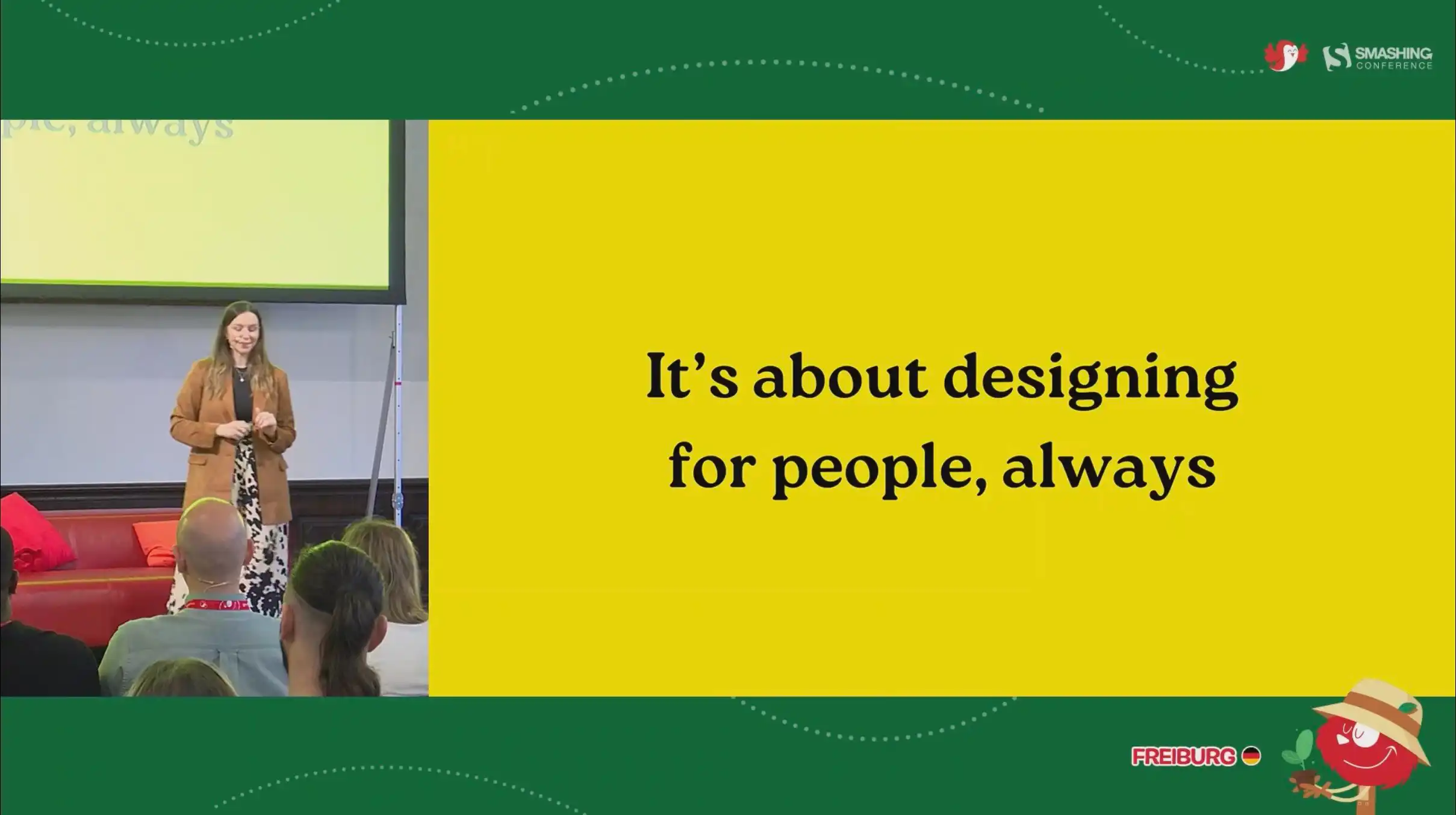
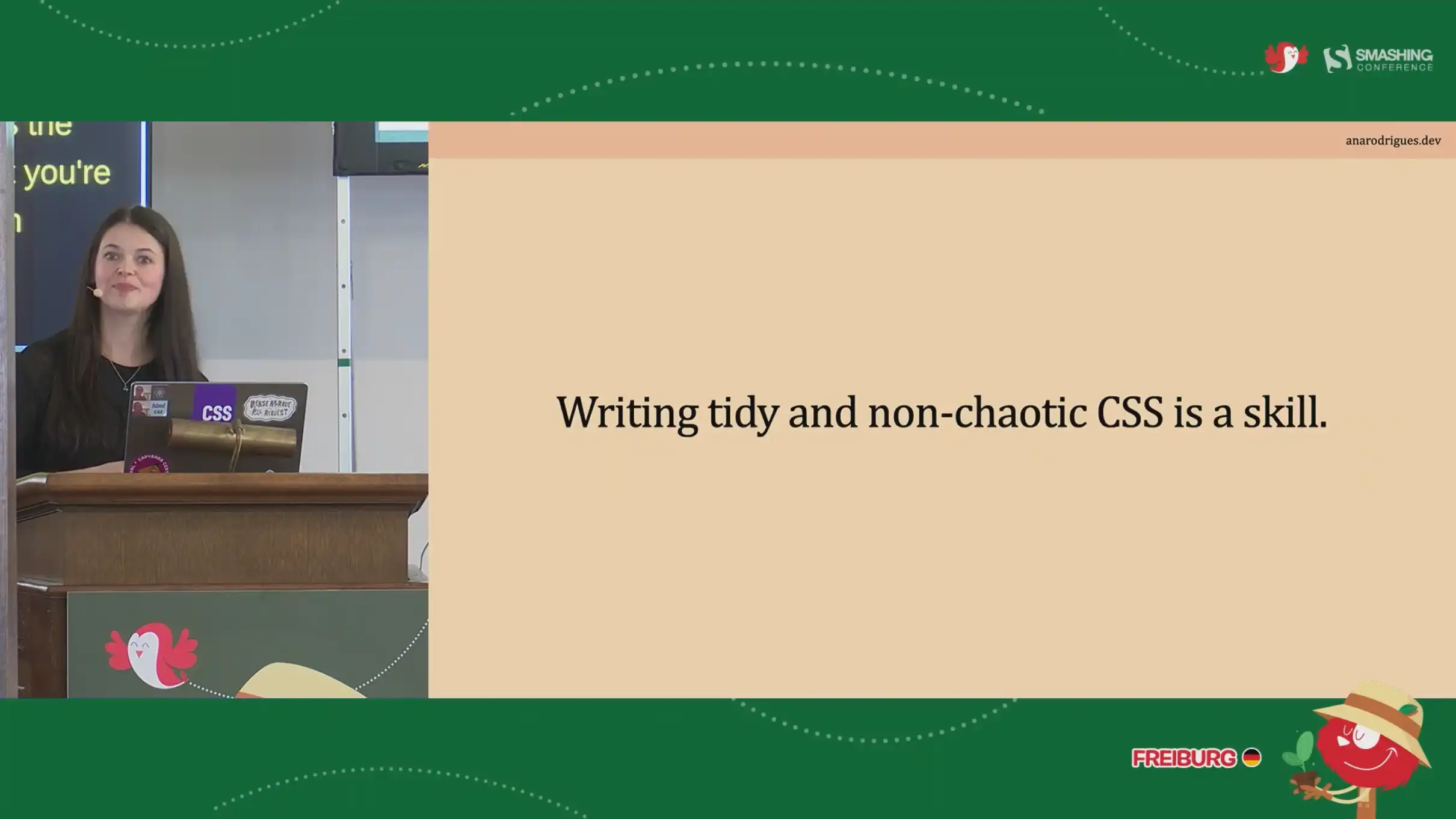
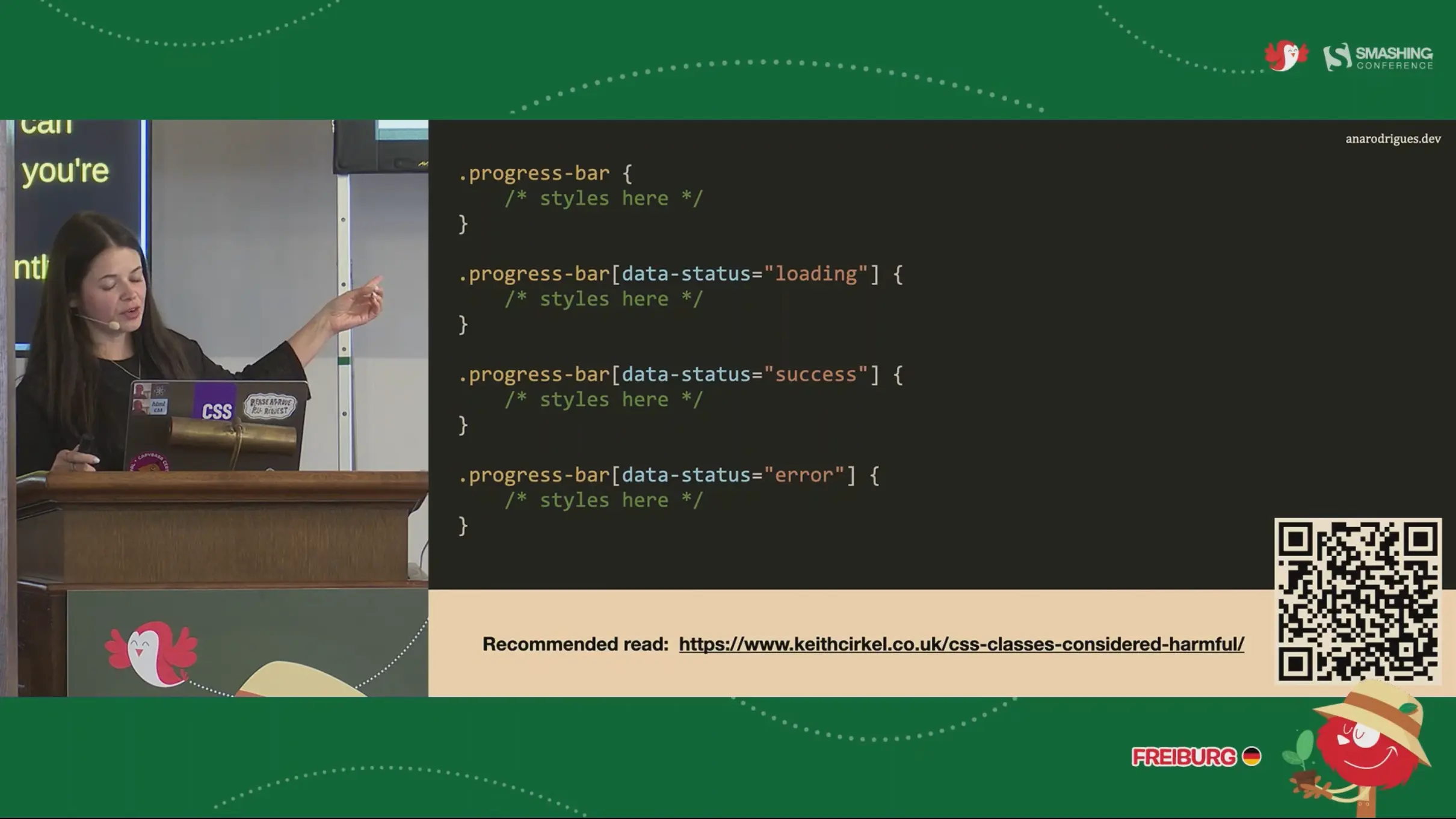
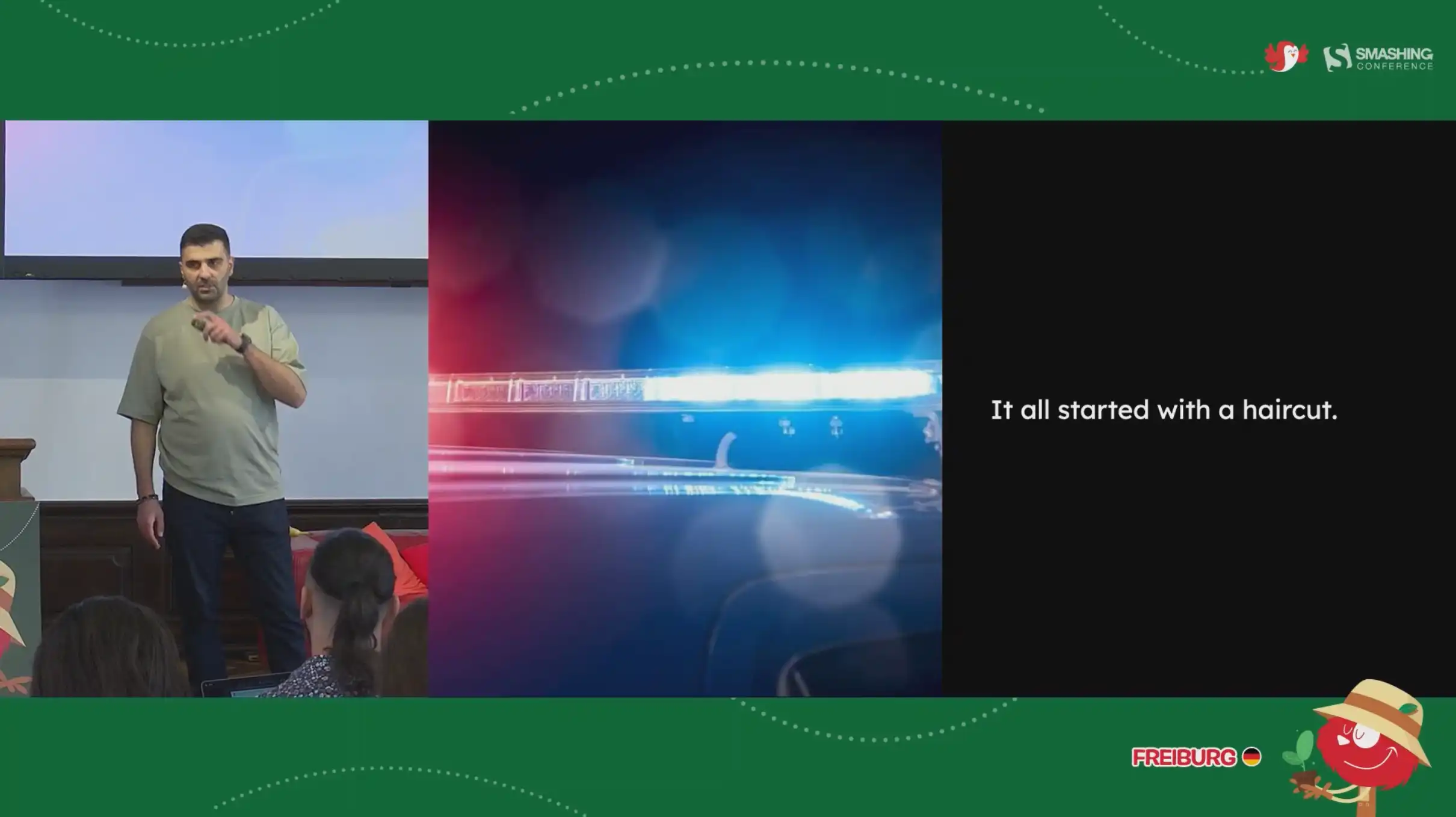
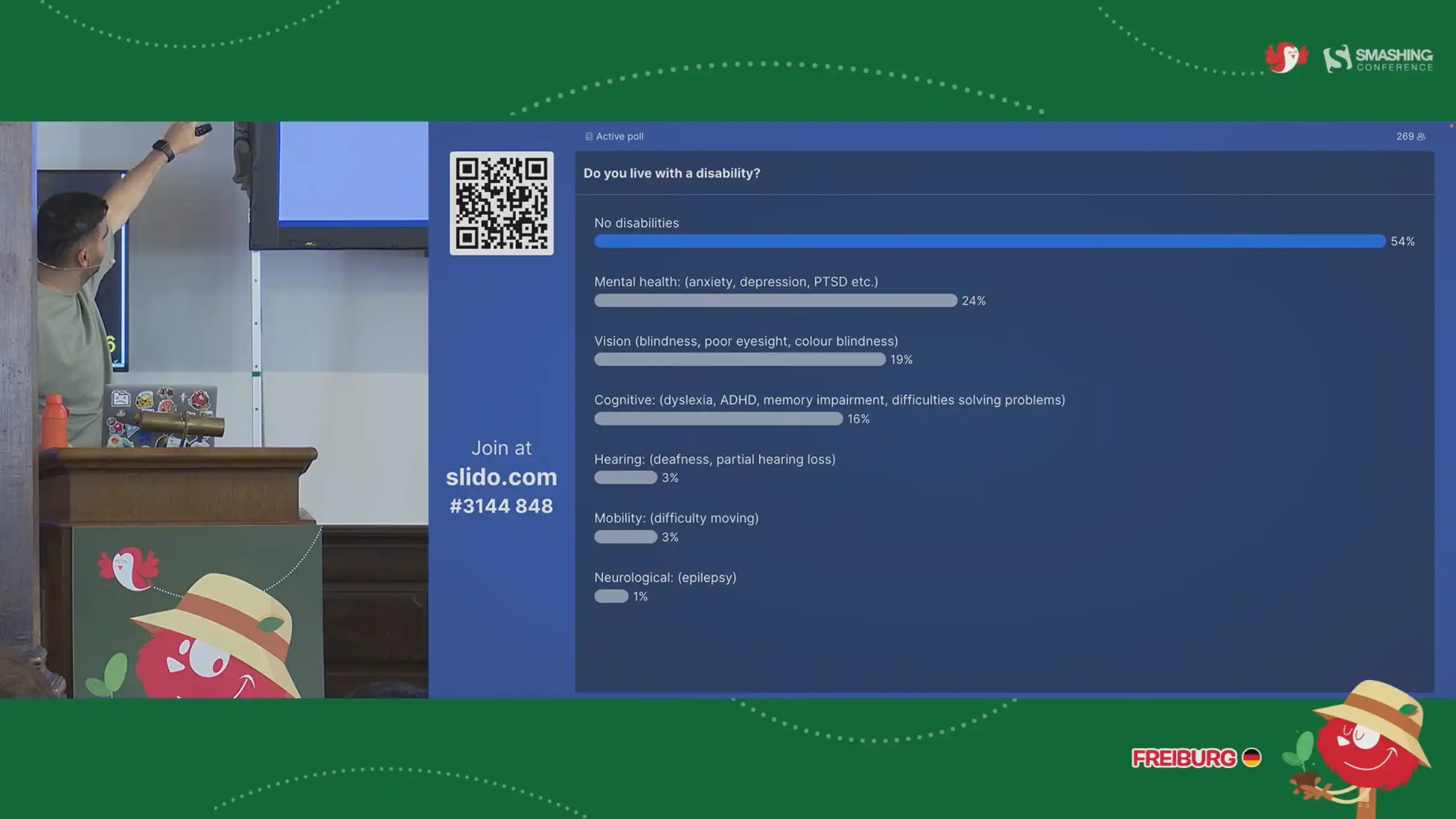
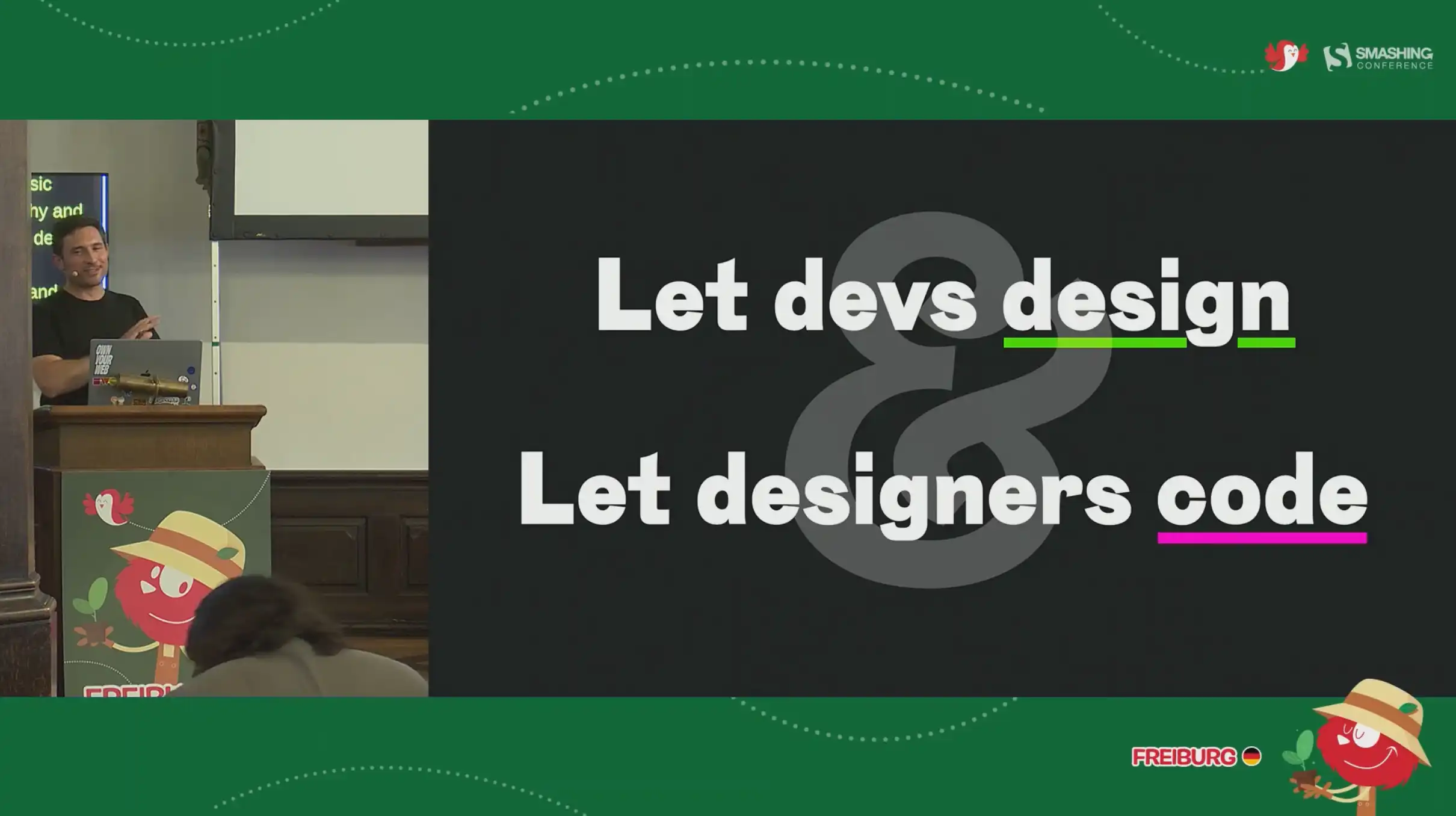
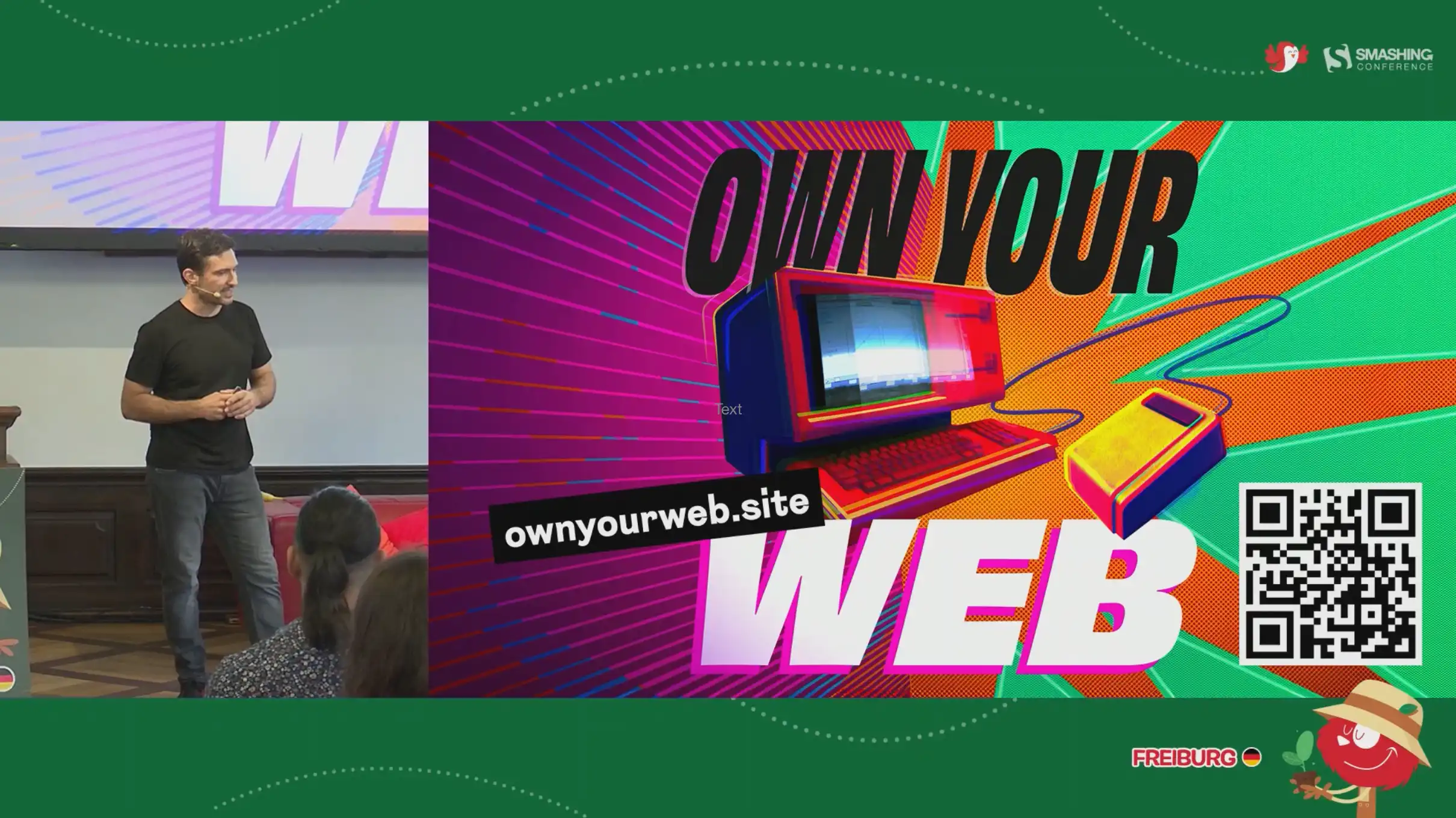
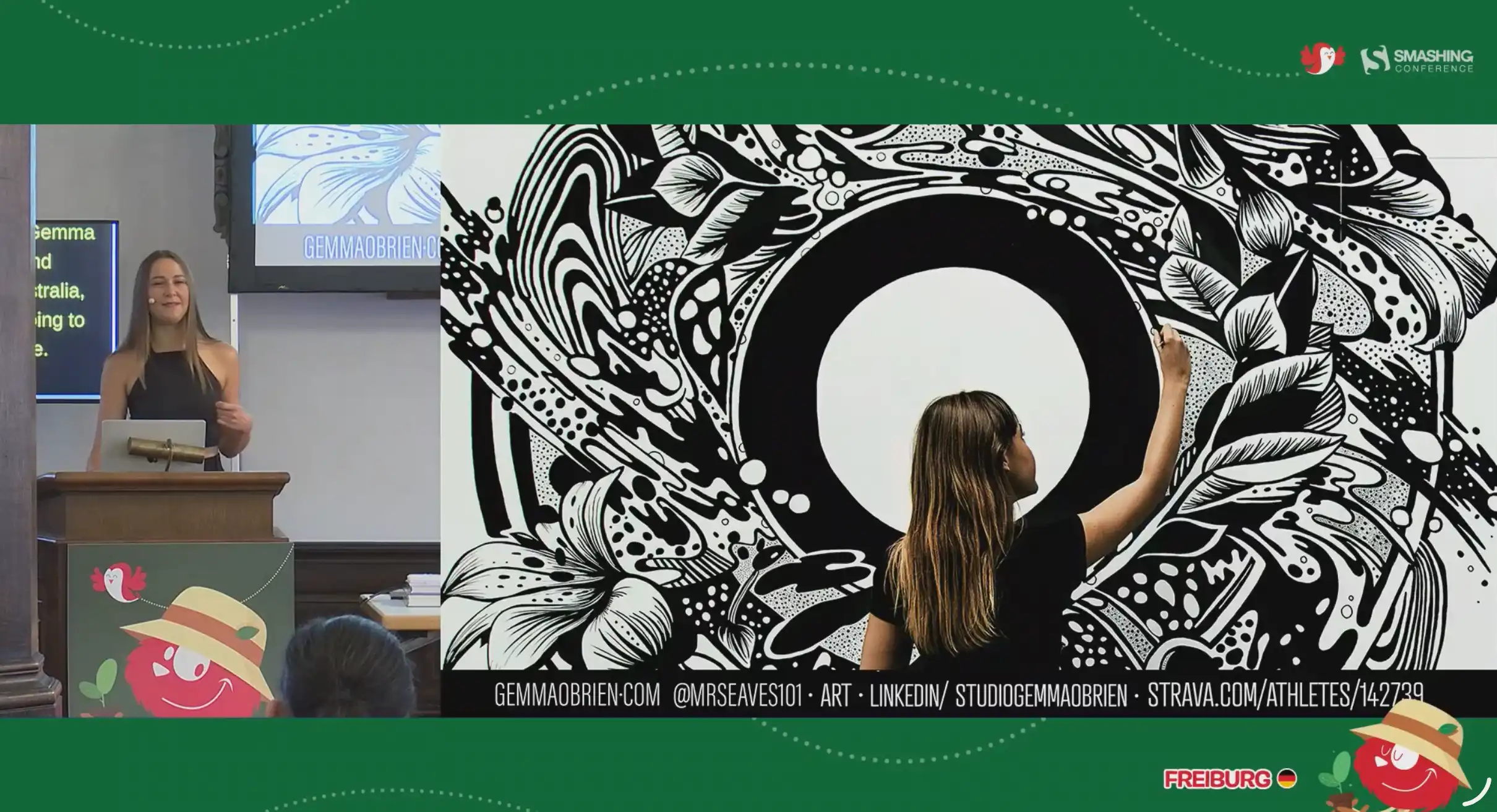
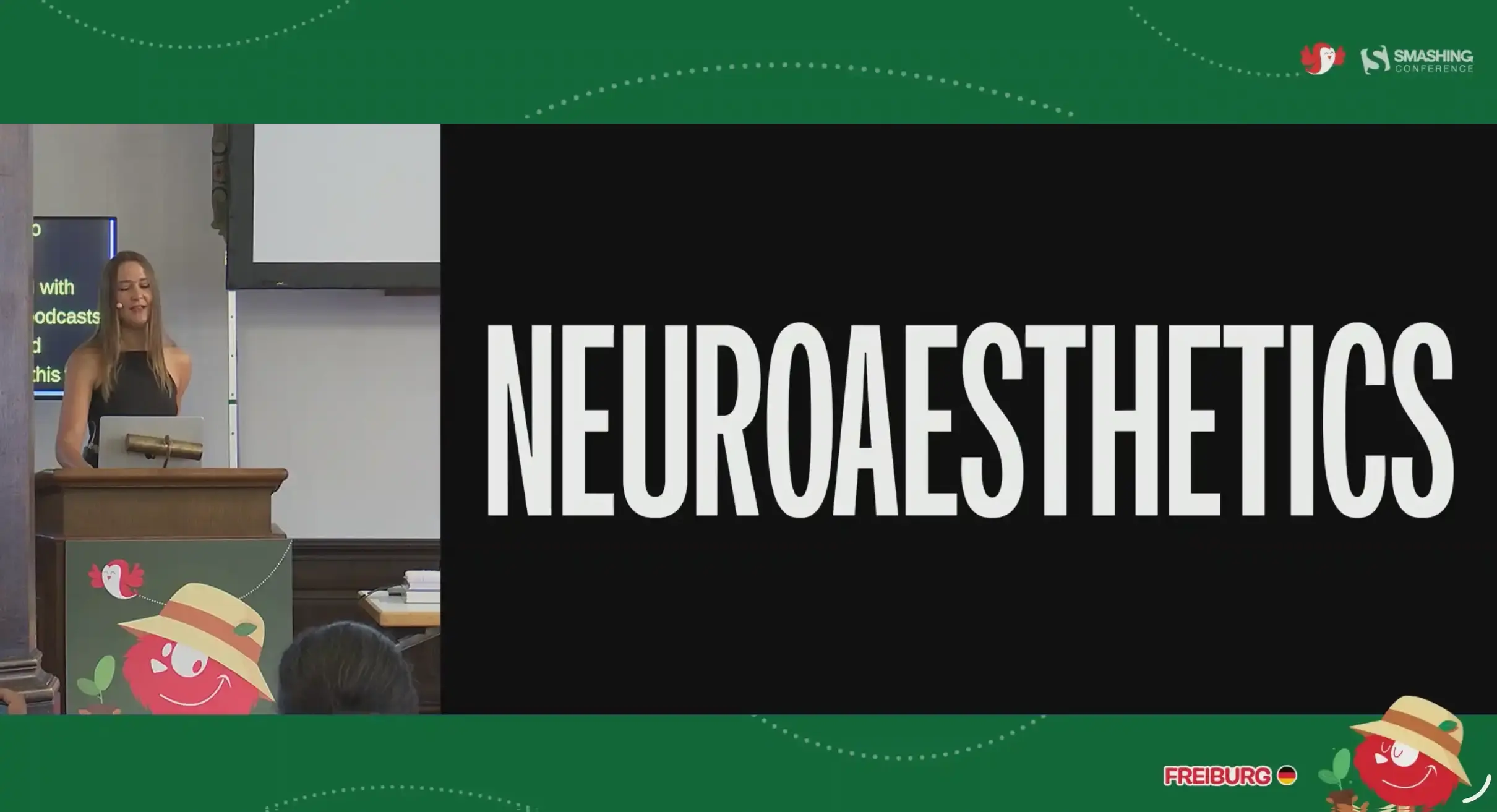
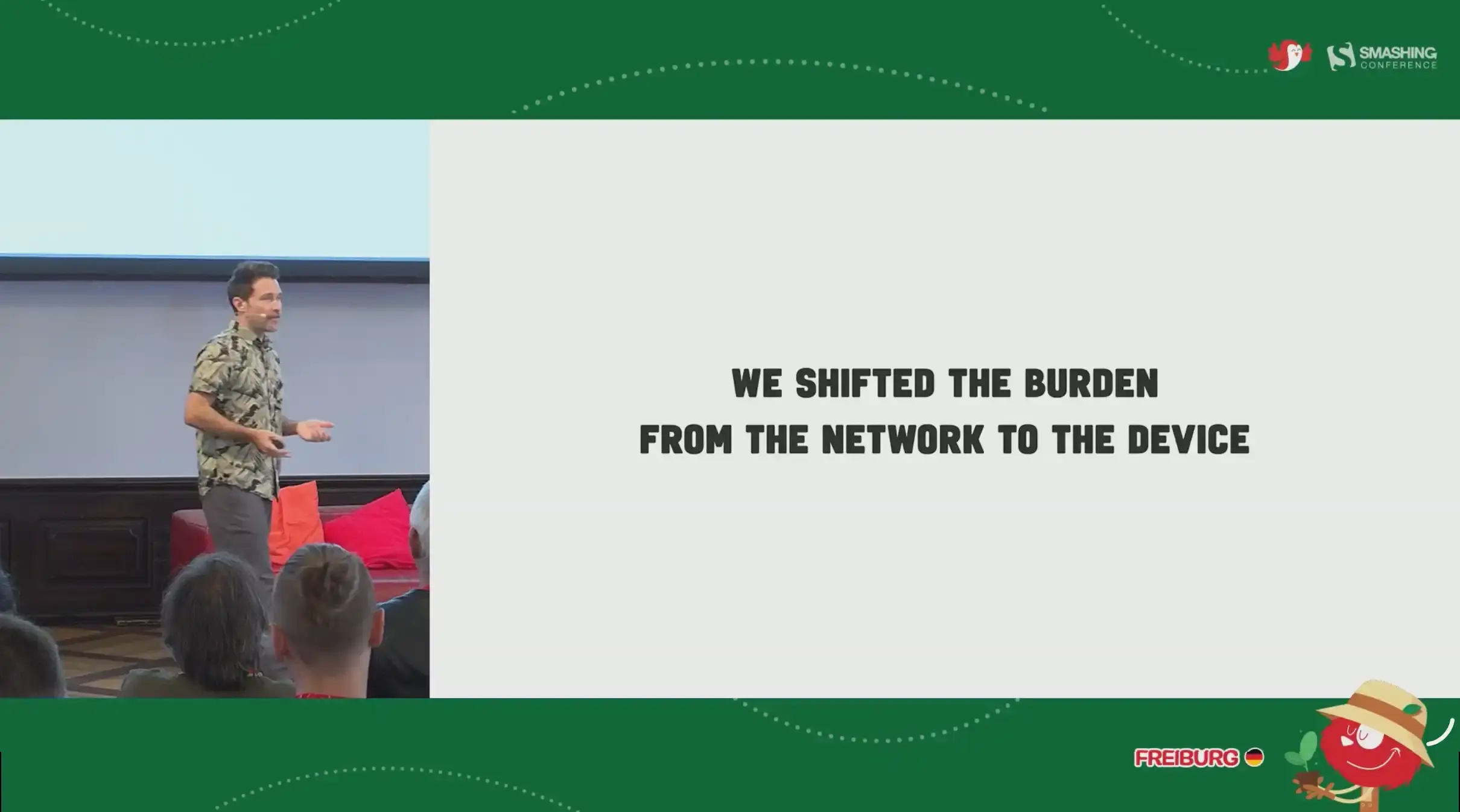
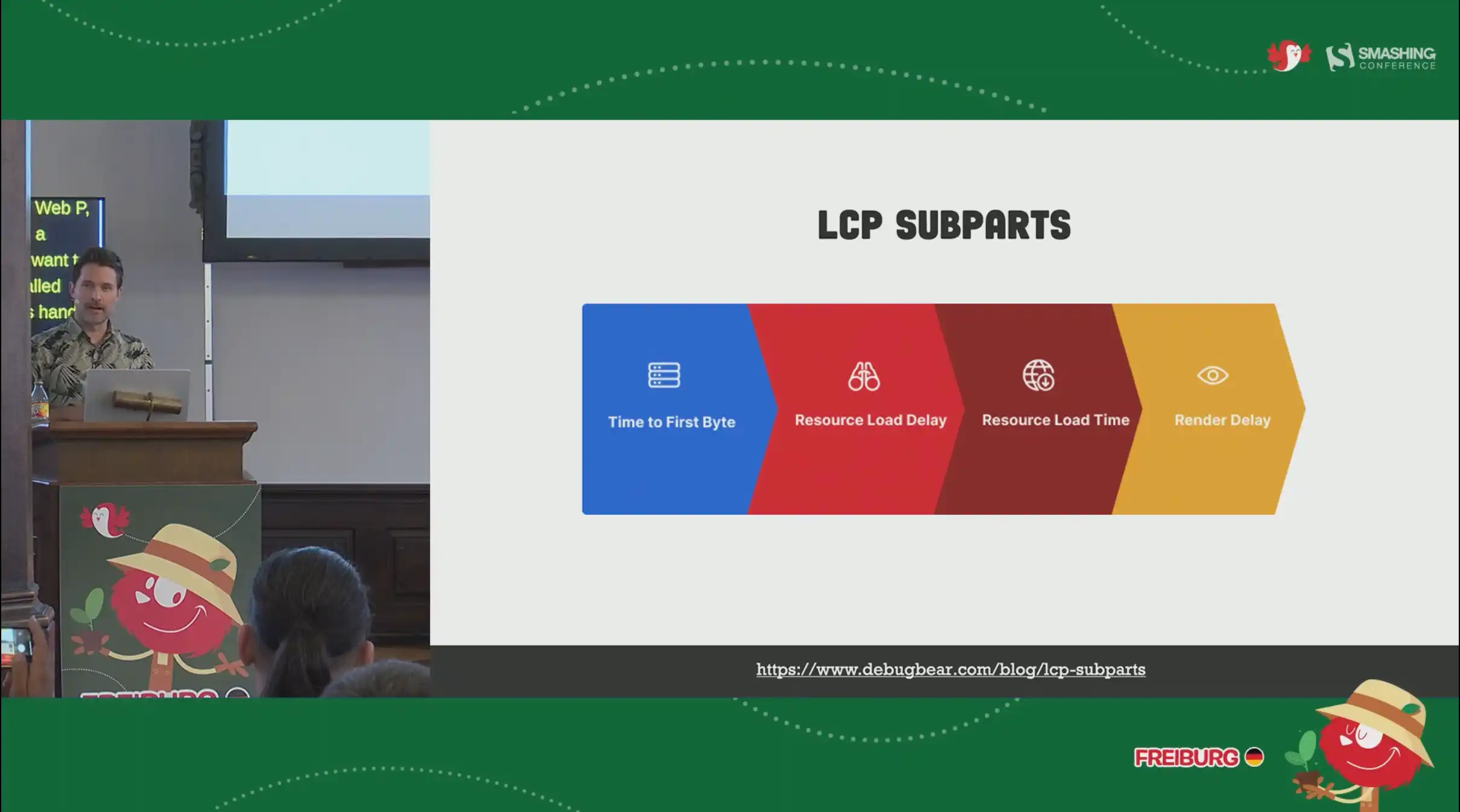
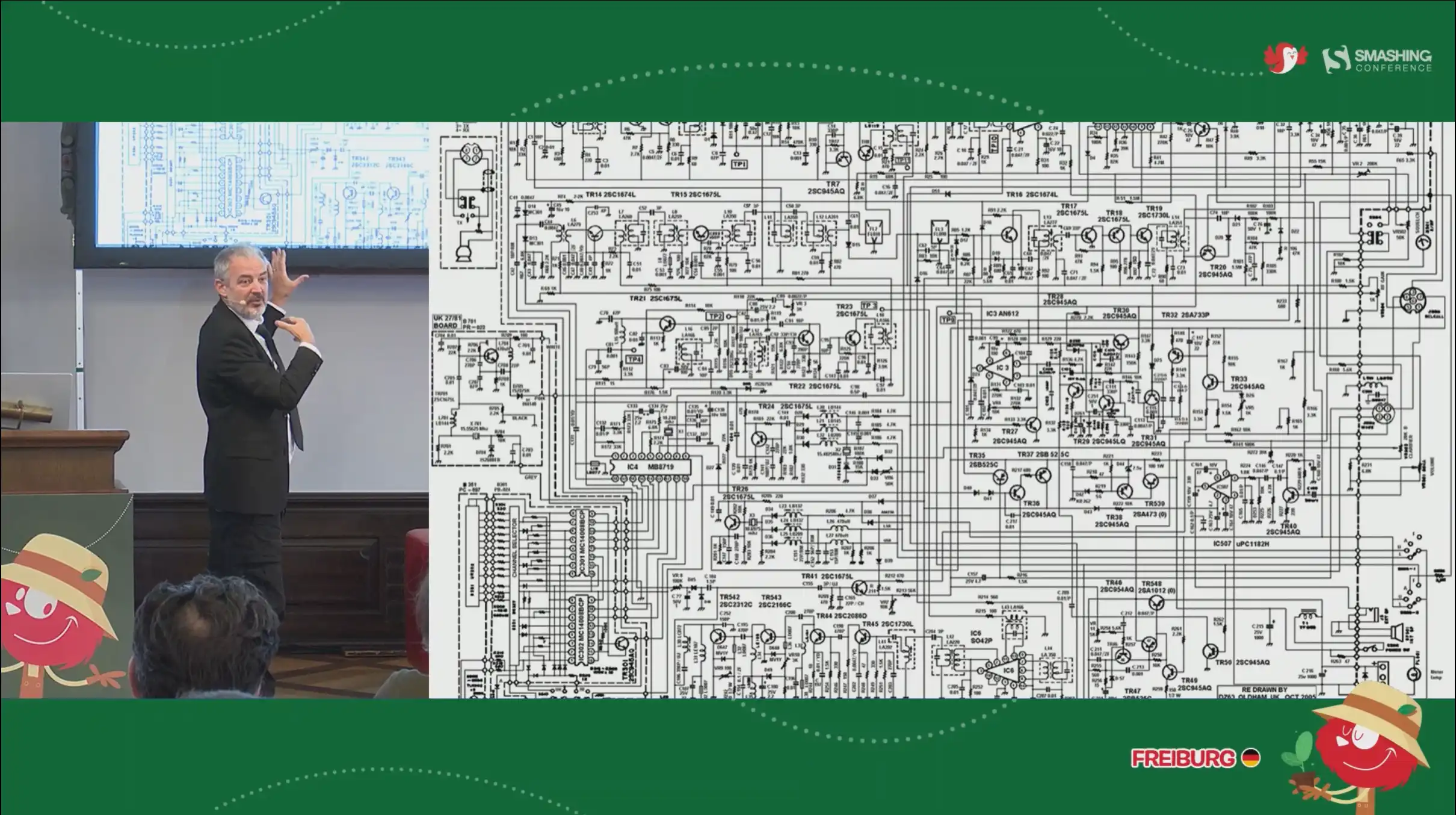
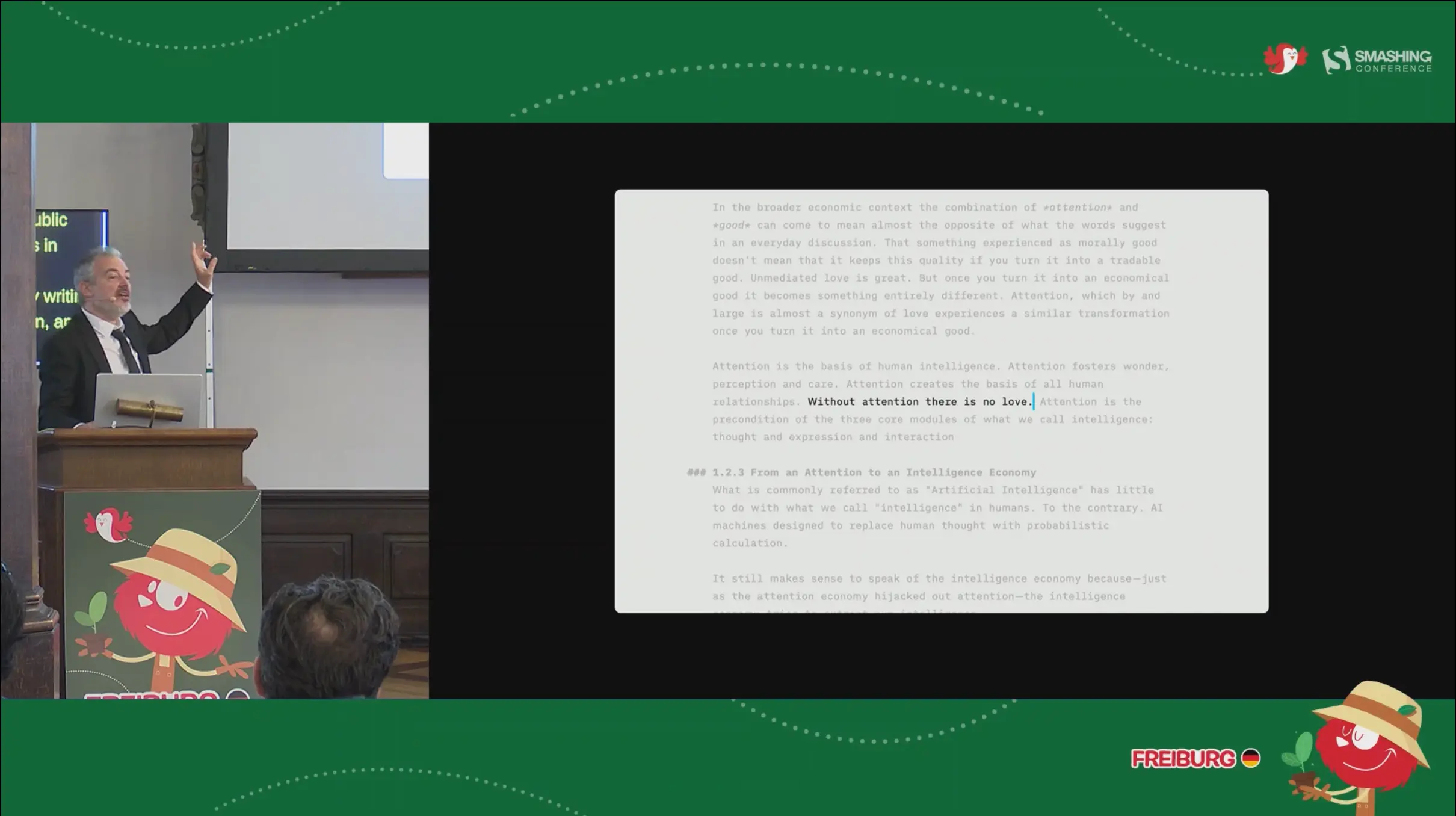
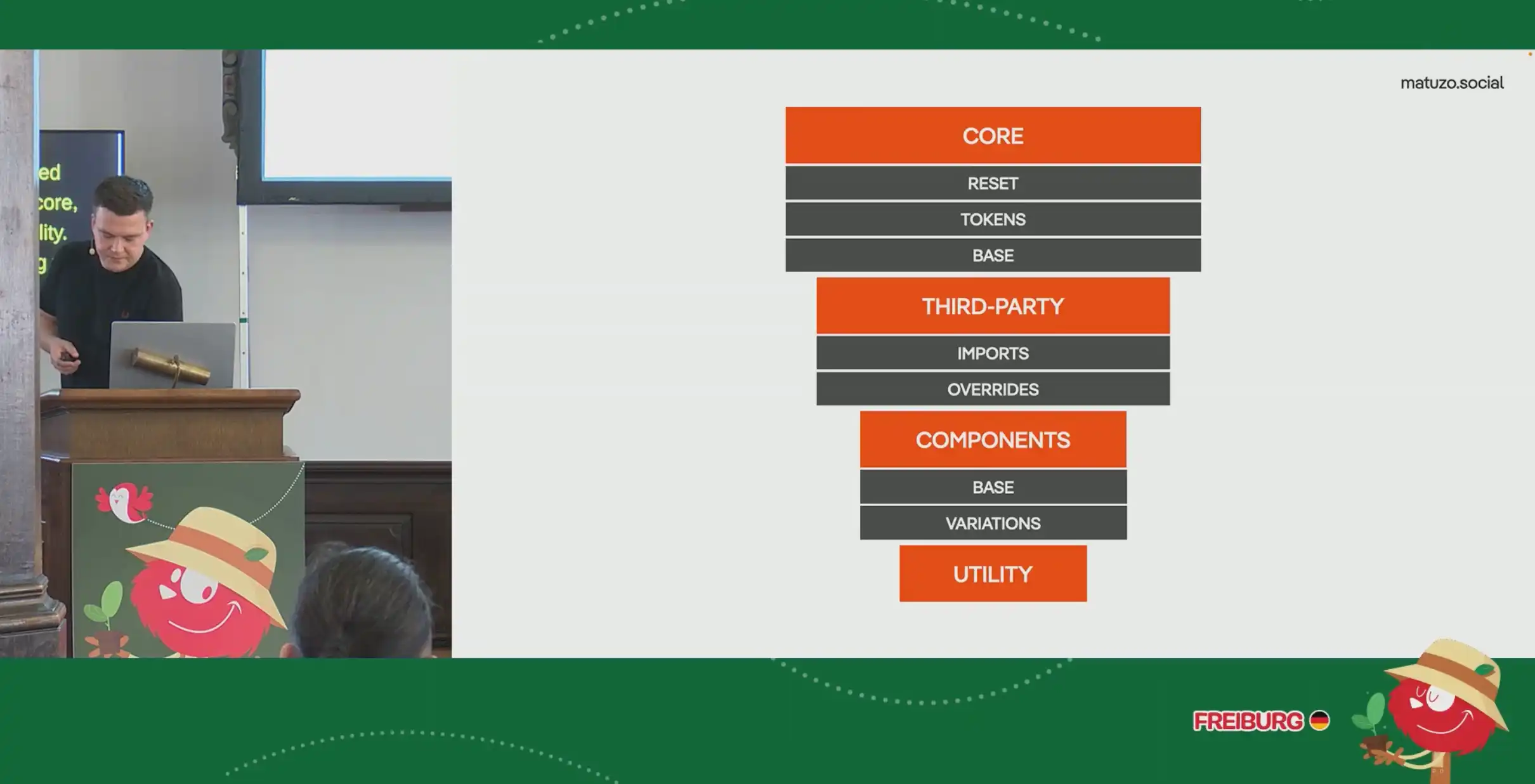
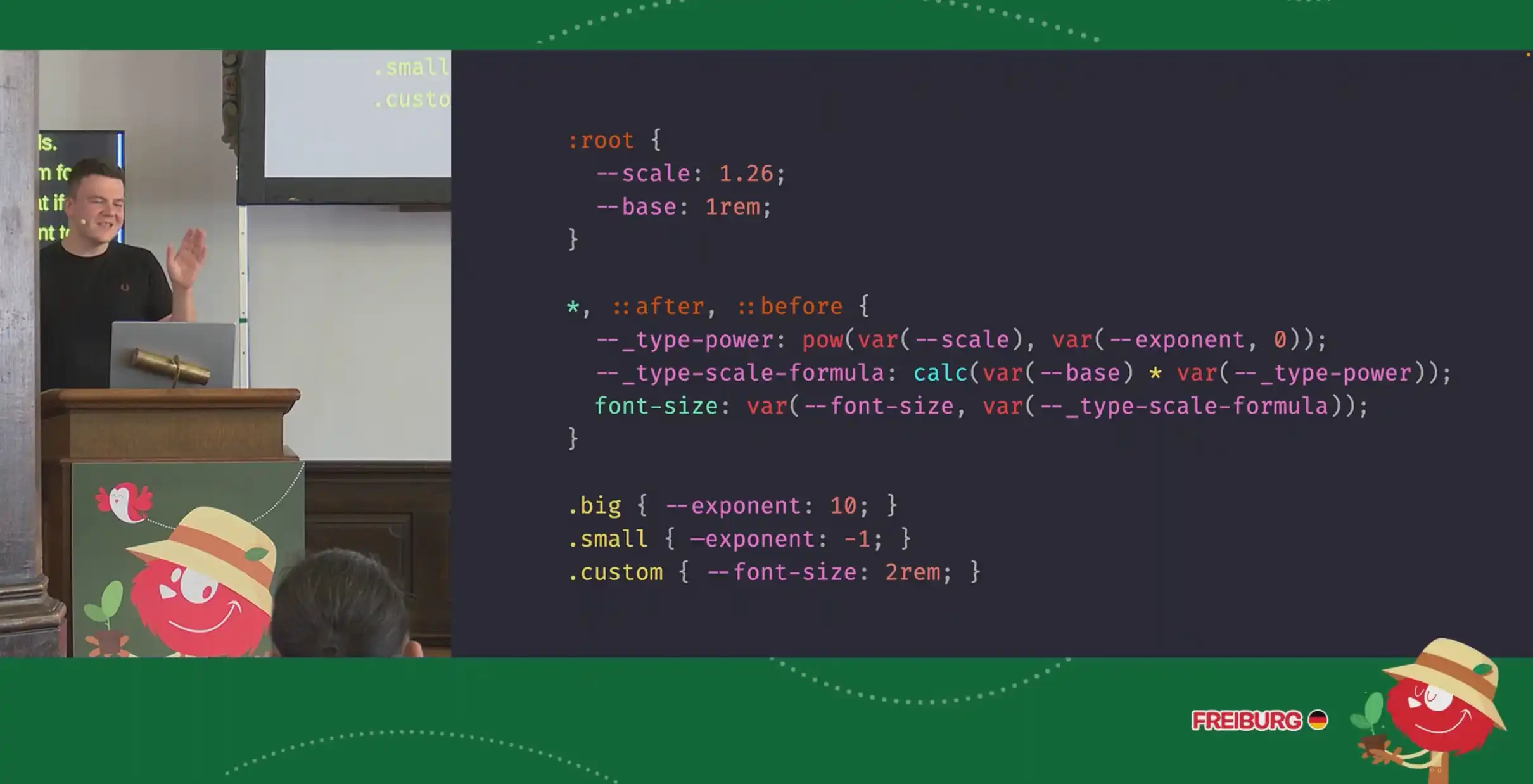
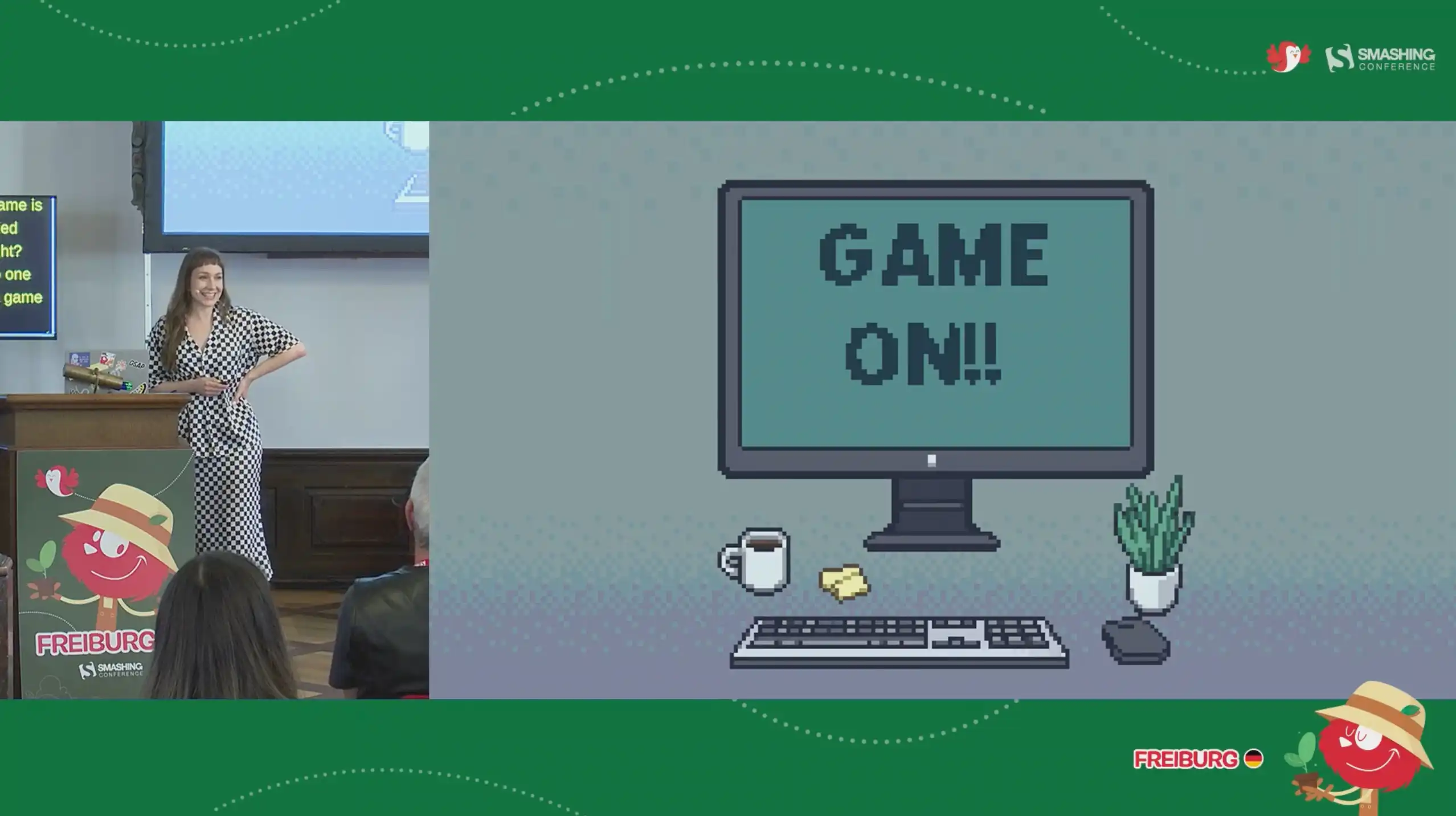
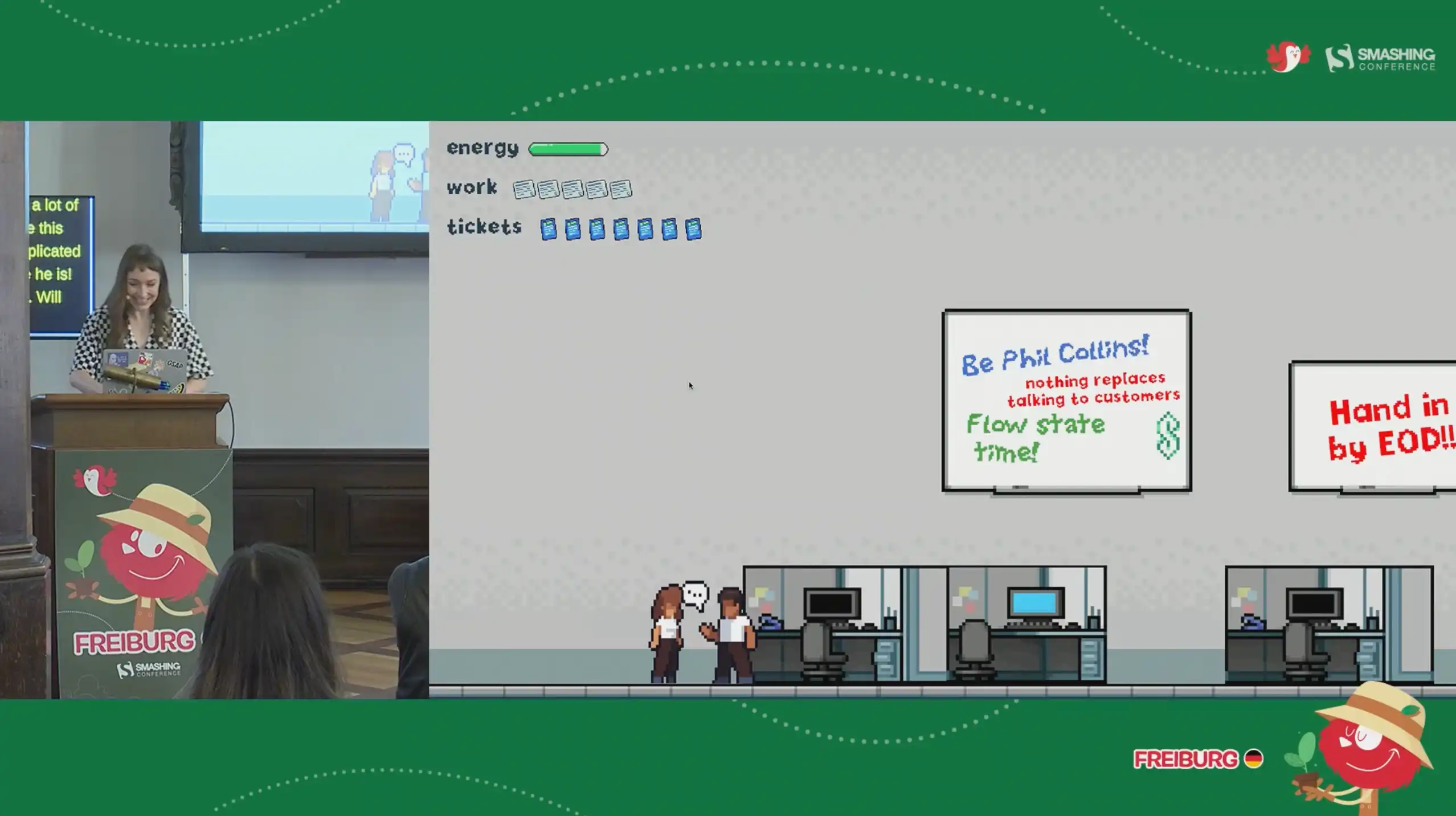
Comments and responses
15 Sep 2025
16 Sep 2025
16 Sep 2025
16 Sep 2025
16 Sep 2025
16 Sep 2025